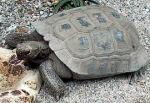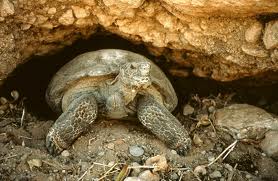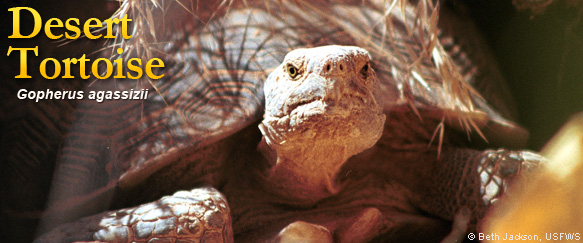
The desert tortoise (Gopherus agassizii) is a large herbivore and the official reptile in the states of California and Nevada. No other tortoise in North America shares the extreme conditions of habitats occupied by the desert tortoise.
Fast Facts
Height: 4-6 inches.
Length: 9-15 inches (shell length).
Weight: 8-15 lbs.
Lifespan: 50-80 years.
The desert tortoise has a high domed shell, or carapace, that is greenish to dark brown in color. Its front limbs have heavy, claw-like scales and their flat shapes are well-designed for digging.
Diet
Varies throughout the desert tortoise’s range. A desert tortoise’s diet may include herbs, grasses, some shrubs and the new growth of cacti and their flowers.
Population
The number of desert tortoises has decreased by 90% since the 1950’s. Recent estimates indicate that there are about 100,000 individual desert tortoises existing in the Mojave and Sonoran deserts.As late as the 1950’s the desert tortoise population averaged at least 200 adults per square mile. More recent studies show the level is now between 5-60 adults per square mile.
Range
The desert tortoise can be found in the Mojave and Sonoran Deserts of southern California, Nevada and Utah. They inhabit semi-arid grasslands, desert washes and sandy canyon bottoms below 3,500 ft
Behavior
The desert tortoise is able to live where ground temperatures may exceed 140 degrees F because of its ability to dig underground burrows to escape the heat. It is one of the most elusive inhabitants of the desert, spending up to 95% of its time under ground to escape the heat of the summer and the cold of winter. They live in burrows which they dig. These can be 3-6 feet deep. They will spend November through February in a torpid or dormant state in their underground burrows.
Their most active time is in the spring when they will forage for food. During the hottest, driest periods of the year the tortoise conserves water already stored in its body. This is especially important in the hot, dry Mojave Desert summers. Winter hibernation aids in minimizing water loss.
Much of the tortoise’s water intake comes from moisture in the grasses and wildflowers they consume in the spring. To maximize the utilization of infrequent rainfall, tortoises dig catchment basins in the soil, remember where these are, and may be found waiting by them when rain appears imminent. Water that reaches the bladder is not lost to the system but can be drawn upon as needed. Adult tortoises may survive a year or more without access to water.
Reproduction
Mating Season: Late summer to early fall.
Gestation: 10-12 months.
Clutch size: 4-6 eggs.
Females do not breed until they are 15 to 20 years old. Survival of juveniles is low: only 2-3 per 100 hatched may live to become adults.
Climate Change and Other Threats
The desert tortoise is very sensitive to human disturbances, and this has led to the decimation of many of its populations throughout the desert southwest. Increased urban development in the deserts of California and other states have fragmented and reduced suitable habitat. Certain fatal diseases appear to be spreading among tortoise populations. Poaching, the use of off-highway vehicles within tortoise habitat and crushing by automobiles have also continued to threaten tortoise populations.
Ravens cause significant levels of juvenile tortoise predation in some areas of the Mojave Desert with more prevalence of human disturbances.
Climate change projections suggest that difficult times may be ahead for the desert tortoise as heat and droughts expand over the region. Like all reptiles, tortoises have minimal ability to self-regulate their internal temperature, and thus must retreat to the shade of vegetation or their burrows once the air temperature reaches above 91 degrees Fahrenheit, in order to keep their body temperatures out of the danger zone. Droughts also force the tortoises to spend more time in their underground burrows to minimize water loss; thus both heat and drought decreasing the amount of time they are able to spend feeding. Droughts limit the availability of nutritious forage for the tortoises.
Females also lay fewer eggs during drought years. Furthermore, the sex of the young turtles is determined by the soil temperature during incubation. Temperatures above 88.7 degrees Fahrenheit produce female tortoises, so prolonged high temperatures could skew the sex distribution of future generations. Extremely high soil temperatures (above 95 degrees) are lethal to the developing young.
Defenders at Work
Defenders was influential in listing the Mojave population in 1989, and in the early 1990s helped secure key acquisition lands. The Mojave population of the desert tortoise is still declining drastically due to staff constraints, funding shortfalls, and lack of public support for necessary recovery actions. The Desert Tortoise was listed under the Endangered Species Act in 1989 and a team of experts developed a recovery plan to guide its recovery in 1994. Currently there is a mandated review of the recovery plan which Defenders is involved in.
Legal Status/Protection
- Endangered Species Act (ESA): The desert tortoise is listed as threatened.
- IUCN Red List: Vulnerable. Desert tortoises are listed as vulnerable.
- CITES: Desert tortoises are listed in Appendix II.
